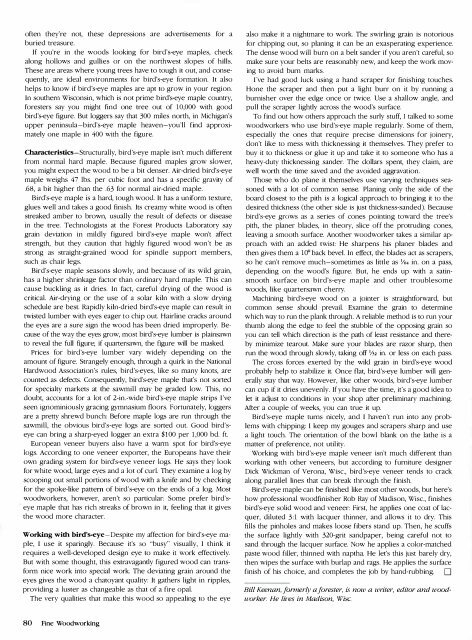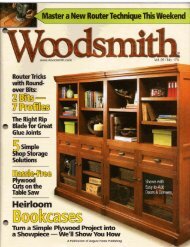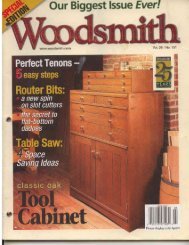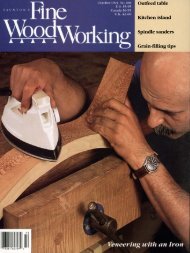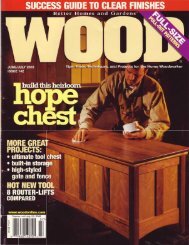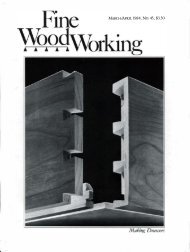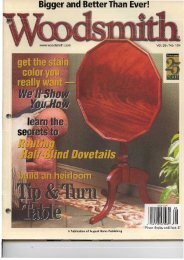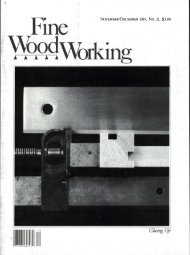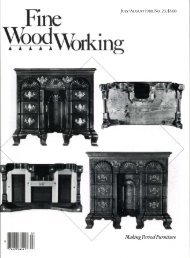Untitled - MetosExpo - Free
Untitled - MetosExpo - Free
Untitled - MetosExpo - Free
Create successful ePaper yourself
Turn your PDF publications into a flip-book with our unique Google optimized e-Paper software.
often they're not, these depressions are advertisements for aburied treasure.If you're in the woods looking for bird's-eye maples, checkalong hollows and gullies or on the northwest slopes of hills.These are areas where young trees have to tough it out, and consequently,are ideal environments fo r bird's-eye fo rmation. It alsohelps to know if bird's-eye maples are apt to grow in your region.In southern Wisconsin, which is not prime bird's-eye maple country,foresters say you might find one tree out of 10,000 with goodbird's-eye figure. But loggers say that 300 miles north, in Michigan'supper peninsula-bird's-eye maple heaven-you'll find approximatelyone maple in 400 with the figure.Characteristics-Structurally, bird's-eye maple isn't much differentfrom normal hard maple. Because figured maples grow slower,you might expect the wood to be a bit denser. Air-dried bird's-eyemaple weighs 47 Ibs. per cubic foot and has a specific gravity of.68, a bit higher than the .63 fo r normal air-dried maple.Bird's-eye maple is a hard, tough wood. It has a uniform texture,glues well and takes a good finish. Its creamy white wood is oftenstreaked amber to brown, usually the result of defects or diseasein the tree. Technologists at the Forest Products Laboratory saygrain deviation in mildly figured bird's-eye maple won't affectstrength, but they caution that highly figured wood won't be asstrong as straight-grained wood fo r spindle support members,such as chair legs.Bird's-eye maple seasons slowly, and because of its wild grain,has a higher shrinkage factor than ordinary hard maple. This cancause buckling as it dries. In fact, careful drying of the wood iscritical. Air-drying or the use of a solar kiln with a slow dryingschedule are best. Rapidly kiln-dried bird's-eye maple can result intwisted lumber with eyes eager to chip out. Hairline cracks aroundthe eyes are a sure sign the wood has been dried improperly. Becauseof the way the eyes grow, most bird's-eye lumber is plainsawnto reveal the full figure; if quartersawn, the figure will be masked.Prices for bird's-eye lumber vary widely depending on meamount of figure. Strangely enough, through a quirk in the NationalHardwood Association's rules, bird's-eyes, like so many knots, arecounted as defects. Consequendy, bird's-eye maple that's not sortedfor specialty markets at the sawmill may be graded low. This, nodoubt, accounts for a lot of 2-in.-wide bird's-eye maple strips I'veseen ignominiously gracing gymnaSium floors. Fortunately, loggersare a pretty shrewd bunch: Before maple logs are run through thesawmill, the obvious bird's-eye logs are sorted out. Good bird'seyecan bring a sharp-eyed logger an extra $100 per 1,000 bd. ft.European veneer buyers also have a warm spot for bird's-eyelogs. According to one veneer exporter, the Europeans have theirown grading system for bird's-eye veneer logs. He says they lookfor white wood, large eyes and a lot of curl. They examine a log byscooping out small portions of wood with a knife and by checkingfor the spoke-like pattern of bird's-eye on the ends of a log. Mostwoodworkers, however, aren't so particular: Some prefer bird'seyemaple that has rich streaks of brown in it, feeling that it givesthe wood more character.Working with bird's-eye- Despite my affection for bird's-eye maple,I use it sparingly. Because it's 0 "busy" visually, I think itrequires a well-developed design eye to make it work effectively.But with some thought, dlis extravagantly figured wood can transformnice work into special work. The deviating grain around theeyes gives the wood a chatoyant quality: It gathers light in ripples,providing a luster as changeable as that of a fire opal.The very qualities that make this wood so appealing to the eyealso make it a nightmare to work. The swirling grain is notoriousfor chipping out, so planing it can be an exasperating experience.The dense wood will burn on a belt sander if you aren't careful, somake sure your belts are reasonably new, and keep the work movingto avoid burn marks.I've had good luck using a hand scraper for finishing touches.Hone the scraper and then put a light burr on it by running aburnisher over the edge once or twice. Use a shallow angle, andpull the scraper lightly across the wood's surface.To find out how others approach the surly stuff, I talked to somewoodworkers who use bird's-eye maple regularly. Some of them,especially the ones that require precise dimensions for jOinery,don't like to mess with thicknessing it themselves. They prefer tobuy it to thickness or glue it up and take it to someone who has aheavy-duty thicknessing sander. The dollars spent, they claim, arewell worth the time saved and the avoided aggravation.Those who do plane it themselves use varying techniques seasonedwith a lot of common sense. Planing only the side of theboard closest to the pith is a logical approach to bringing it to thedesired thickness (the other side is just thickness-sanded). Becausebird's-eye grows as a series of cones pointing toward the tree'spith, the planer blades, in theory, slice off the protruding cones,leaving a smooth surface. Another woodworker takes a similar approachwith an added twist: He sharpens his planer blades andthen gives them a l(f back bevel. In effect, the blades act as scrapers,so he can't remove much-sometimes as little as Y64 in. on a pass,depending on the wood's figure. But, he ends up with a satinsmoothsurface on bird's-eye maple and other troublesomewoods, like quartersawn cherry.Machining bird's-eye wood on a jointer is straightforward, butcommon sense should prevail. Examine the grain to determinewhich way to run the plank through. A reliable method is to run yourthumb along the edge to feel the srubble of the opposing grain soyou can tell which direction is the path of least resistance and therebyminimize tearout. Make sure your blades are razor sharp, thenrun the wood through slowly, taking off Y32 in. or less on each pass.The cross forces exerted by the wild grain in bird's-eye woodprobably help to stabilize it. Once flat, bird's-eye lumber will generallystay dut way. However, like other woods, bird's-eye lumbercan cup if it dries unevenly. If you have the time, it's a good idea tolet it adjust to conditions in your shop after preliminary machining.After a couple of weeks, you can true it up.Bird's-eye maple turns nicely, and I haven't run into any problemswith chipping: I keep my gouges and scrapers sharp and usea light touch. The orientation of the bowl blank on the lathe is amatter of preference, not utility.Working with bird's-eye maple veneer isn't much different thanworking widl other veneers, but according to furniture designerDick Wickman of Verona, Wisc., bird's-eye veneer tends to crackalong parallel lines that can break dlroUgh the finish.Bird's-eye maple can be finished like most other woods, but here'show profeSSional woodfinisher Rob Ray of Madison, Wisc., finishesbird's-eye solid wood and veneer: First, he applies one coat of lacquer,diluted 3:1 with lacquer thinner, and allows it to dry. Thisfi lls the pinholes and makes loose fibers stand up. Then, he scuffsthe surface lightly with 320-grit sandpaper, being careful not tosand through the lacquer surface. Now he applies a color-matchedpaste wood filler, thinned with naptha. He let's this just barely dry,then wipes the surface with burlap and rags. He applies the surfacefinish of his choice, and completes the job by hand-rubbing. 0Bill Keenan, fOI-merly a forester, is now a writer, editor and woodworker.He lives in Madison, Wise.80 Fine Woodworking


